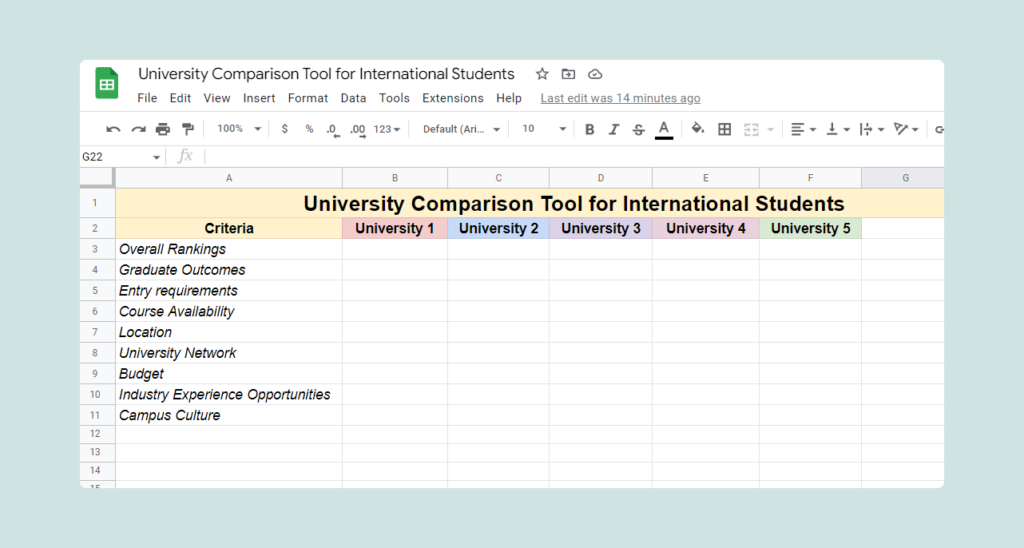How To Choose The Right University In Australia For Your Studies?

There are more than 40 universities offering thousands of courses to international students for studying in Australia.
The question is which one is the right one for you?
Choosing the right course and university in Australia can be hard work, but it’s worth the effort. Of course, if you choose the wrong one, then it can severely impact your career.
Things can become more complicated if you have multiple options to choose from.
Luckily, in this guide we will give you important things to consider on how to choose the right university in Australia for your studies.

1. University Rankings
It’s usual for anyone to look at a university’s ranking first when choosing to study abroad and that’s perfectly okay.
However, before you do so, let’s look at what factors these rankings truly consider for rating the universities around the globe.
It’s not necessary to fully understand everything about these rankings, but since rankings are frequently taken into account when making decisions, it’s a good idea to have a broad understanding of them.
Although there are many university ranking systems, these are the ones that are most frequently used:
- Times Higher Education World University Rankings
- QS World University Rankings
The technique employed by each university ranking system varies significantly.
However, the following elements are the ones that are most frequently used to rate an institution:
- The total number of students
- The student-teacher ratio
- Student gender ratio
- Proportion of international students
- Quality of teaching
- Employability skills
- Volume of citations and research
The quantity, quality, and impact of universities’ research, as well as the number of citations they receive from academics throughout the world, are by far the main elements used to rank universities.
Therefore, rankings are unquestionably an excellent indicator of university quality that you should look into when choosing the university for your studies.
But apart from the rankings, you should also consider the other important factors, which include teaching quality, location, variety of courses provided, etc. All these things influence an international student’s decision to choose an Australian university.
2. Graduate Outcomes
Australia’s QILT program uses government endorsed surveys to collect data on graduation outcomes, student satisfaction, and employer outcomes in a transparent and understandable way.
Students can use this data to evaluate the Australian universities on teaching, graduation rates, and other factors.
As graduate outcomes are an important measure for the students, choosing the universities with higher graduate outcomes rates makes sense.
You can check more details about these survey results from the QILT website.
3. University Network
In Australia, there are 3 main types of university networks. These are:
- Innovative Research Universities,
- Australian Technology Network, and
- Go8 Universities.
Innovative research universities
This group of universities focus on teaching and research excellence. The following universities are the part of innovative research universities network:
- La Trobe University
- Griffith University
- Flinders University
- Murdoch University
- Charles Darwin University
- James Cook University
- Western Sydney University
Australian Technology Network
Apart from innovative research universities, there are a group of 6 universities that are working on enterprise, impact and finding solutions to issues facing our economy and society.
These universities come under the hood of ATN also known as Australian Technology Network. They are
- Curtin University,
- Deakin University,
- RMIT University,
- The University of Newcastle,
- University of South Australia, and
- University of Technology Sydney.
Go8 University
Also known as the Ivy League of Australian universities, the Go8 universities are a collection of eight Australian institutions that are forerunners in research-intensive education.
The Group Eight Universities in Australia place a strong emphasis on forging elite international alliances and collaborative research projects, as well as developing and shaping long-term economic higher education.
These universities are:
- Australian National University
- The University of Melbourne
- The University of Sydney
- The University of Queensland
- The University of Western Australia
- Monash University
- The University of Adelaide
- The University of New South Wales
4. Entry requirements
The entry requirements for studying in Australia varies from one university to the others.
For example, some universities might be okay with you having scored only 60% scores in your high school or graduation, other might not accept your application due to higher scores requirements.
Similarly, some universities might be fine with the minimum scores in English Language Test like IELTS, while others might not.
There might be some additional entry requirements like taking a special exam like GMAT, work experience, submission of previous portfolios wtc for some universities.
It is important to understand that the entry requirements not only vary from institute to institute but also with the level of education.
We have got a complete breakdown of entry requirements for each qualification level in Australia here.

5. Availability Of The Course
Another very critical factor is the availability of the courses in a specific university.
So let’s say you decided to do a Bachelor in Marine and Antarctic Sciences in Australia and you did some research and found that there is only one university in Australia that provides this course, The University of Tasmania.
In that case, you will be limited in your choice of university. The point we are trying to make here is that sometimes your preferred course might be available at the university you want to study. In that case, you will need to filter out your options.
The courses that are offered, the length of the course, the tuition costs, and the kinds of scholarships that are available are some of the main variables that influence foreign students to narrow down their choice of Australian universities.
It will be difficult for the student to remain with their initial decision if the course and institution are not a good fit for them, which may result in changing their minds and enrolling in different programs.
6. Location Of The University
Location of the university is another factor that students should consider when choosing the right university. There are few reasons for that.
First one is that studying in regional areas can give you access to additional post-study work visas in Australia. As per the Department of the Home Affairs website, the whole country is divided into 3 tiers for post study work rights:
- Tier 1: Major Cities: Sydney, Melbourne, Brisbane
- Tier 2: Cities and Major Regional Centres: Perth, Adelaide, Gold Coast, Sunshine Coast, Canberra, Newcastle, Lake Macquarie, Wollongong, Illawarra, Geelong, Hobart.
- Tier 3: Regional Areas and Other Regional Centres: All other locations
Depending on the area you are studying in Australia, this can lead to additional timeframes for Post Study work rights for the students.
You can check our complete guide on regional areas study here.
Apart from additional timeframes, students have to be mindful of the cost of living associated with the location of the university.
Choosing a university in a smaller city or a regional area may mean fewer travel expenses, less money spent on housing, and less money spent on personal expenses.
Studying in larger cities means more expenses and spending but also means more job opportunities as well.
Therefore, location must be considered while choosing the right university in Australia.

7. Your Budget (Cost)
Your budget will be a huge factor in deciding to choose the university to study in Australia.
As much as we all want to study in the top universities, we will be limited to fewer options due to our budget constraints and tuition fees.
Your budget will depend on how much savings you and your family have and how much you can borrow from your relatives or a sponsor as well. Many international students also choose to take out a study loan as well.
Luckily, some top universities and the Australian government provide fully funded scholarships to study in Australia for high achieving students. You can check all these fully funded scholarships in Australia here.
But just remember that not everyone will be able to score these scholarships. Many of the students will have to pay for themselves, so budget is another factor when choosing the right university in Australia.
8. Availability of Industry Experience Opportunities
The main purpose of the study is to have the right skill set for the work roles as per your chosen study field.
One of the key factors when deciding the right university is to look at what industry experience opportunities are available at the university for international students.
This can help international students to actually break into real world work opportunities after their studies in Australia.
These industry experience opportunities could be:
- Work placements
- Volunteering,
- Internships and
- Work experience.
9. Understand The Campus Culture
Every university in Australia has its distinct personality and culture that is a direct result of the individuals that attend it as well as its history and traditions of the university. It sets one university apart from the other
While some universities could be more laid back in their approach, others might be more focused on their academic requirements.
Before choosing the right university, you should learn about the university. You can do this by browsing the university website, their social media platforms, official student groups & unions and advertising materials.
Ideally, if you can visit it in person (especially if you are already in Australia), that would be great. But you can certainly do a virtual tour on an Open Day, speak to current and former students, as well as employees of the university.
After doing all this research, you should be able to tell if the university is a right fit for you or not.

We also recommend that you use a simple comparison tool for making an informed choice for your university selection.
We have created this simple spreadsheet that you can use to make a comparison among universities for choosing the right one for you.
To edit the file, please press the “File” and “Make a Copy” button. You can access the file here.
Well that’s all for choosing the right university for your studies in Australia. Hope this article helped you in choosing the right university. Please make sure to share the article with your network if you found any information useful.


